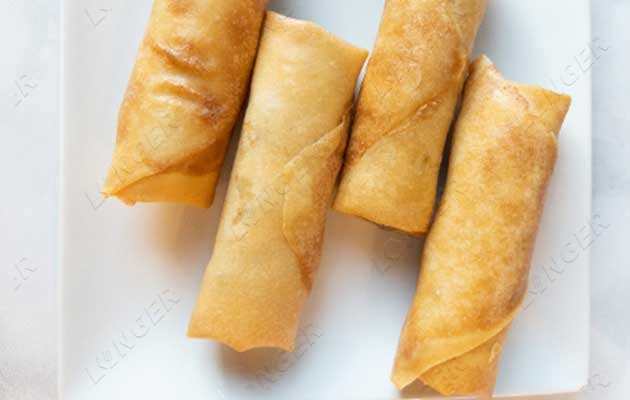How Are Spring Rolls Processed?
2023-08-15
Spring rolls are a beloved and iconic dish in many cuisines, known for their delicate flavors, crispy texture, and the artful combination of fresh ingredients. In this article, we delve into the intriguing journey of how spring rolls are processed in a factory, from sourcing the finest ingredients to packaging the final product.

Ingredient sourcing and preparation
The journey of a spring roll begins with the selection of high-quality ingredients. Vegetables such as carrots, cabbage, mushrooms, bean sprouts, and sometimes protein sources like shrimp or tofu are procured from trusted suppliers. These ingredients are thoroughly inspected for freshness and quality before being prepared for processing.
In the factory, a team of skilled workers cleans, peels, and chops the vegetables using specialized equipment. The ingredients are then carefully measured to ensure consistency in taste and appearance.
Mixing and Seasoning
The prepared vegetables are combined in precise proportions to create the filling mixture. This mixture not only enhances the flavors but also maintains the ideal texture of the spring roll. A secret blend of seasonings and sauces is added to create the signature taste that spring rolls are known for.
Spring roll Wrapper Production
One of the defining features of spring rolls is their thin and crispy wrapper. In the factory, the wrappers are created by mixing flour, water, and other ingredients to form a smooth batter.
Filling and Rolling
The assembly line comes to life as the spring rolls take shape. A precise amount of filling is placed onto each wrapper, and skilled workers use a combination of automation and manual dexterity to roll the wrappers tightly around the filling. The process requires finesse to ensure the rolls are properly sealed and maintain their shape.
Cooking
The rolled spring rolls are now ready for cooking. Depending on the recipe, the spring rolls are either deep-fried or baked to achieve the desired level of crispiness. The cooking time and temperature are carefully monitored to ensure even cooking and a consistent golden-brown color.
Quality Control
Quality control is a critical step in the spring roll processing journey. A team of quality assurance experts inspects the cooked spring rolls for any defects, inconsistencies, or deviations from the desired standards. Any imperfect rolls are removed from the production line to maintain the highest quality.
Packaging
Once the spring rolls pass the rigorous quality checks, they are ready for packaging. The rolls are carefully arranged in trays or individual packets, and packaging materials are selected to preserve freshness and extend shelf life. Labels with nutritional information, cooking instructions, and branding are applied before the final sealing.
The journey of spring rolls from fresh ingredients to delightful treats in a factory is a testament to the art and science of food production. This process takes place usually by fully automatic spring roll production lines, thus guaranteeing fast and efficient production.

Ingredient sourcing and preparation
The journey of a spring roll begins with the selection of high-quality ingredients. Vegetables such as carrots, cabbage, mushrooms, bean sprouts, and sometimes protein sources like shrimp or tofu are procured from trusted suppliers. These ingredients are thoroughly inspected for freshness and quality before being prepared for processing.
In the factory, a team of skilled workers cleans, peels, and chops the vegetables using specialized equipment. The ingredients are then carefully measured to ensure consistency in taste and appearance.
Mixing and Seasoning
The prepared vegetables are combined in precise proportions to create the filling mixture. This mixture not only enhances the flavors but also maintains the ideal texture of the spring roll. A secret blend of seasonings and sauces is added to create the signature taste that spring rolls are known for.
Spring roll Wrapper Production
One of the defining features of spring rolls is their thin and crispy wrapper. In the factory, the wrappers are created by mixing flour, water, and other ingredients to form a smooth batter.
Filling and Rolling
The assembly line comes to life as the spring rolls take shape. A precise amount of filling is placed onto each wrapper, and skilled workers use a combination of automation and manual dexterity to roll the wrappers tightly around the filling. The process requires finesse to ensure the rolls are properly sealed and maintain their shape.
Cooking
The rolled spring rolls are now ready for cooking. Depending on the recipe, the spring rolls are either deep-fried or baked to achieve the desired level of crispiness. The cooking time and temperature are carefully monitored to ensure even cooking and a consistent golden-brown color.
Quality Control
Quality control is a critical step in the spring roll processing journey. A team of quality assurance experts inspects the cooked spring rolls for any defects, inconsistencies, or deviations from the desired standards. Any imperfect rolls are removed from the production line to maintain the highest quality.
Packaging
Once the spring rolls pass the rigorous quality checks, they are ready for packaging. The rolls are carefully arranged in trays or individual packets, and packaging materials are selected to preserve freshness and extend shelf life. Labels with nutritional information, cooking instructions, and branding are applied before the final sealing.
The journey of spring rolls from fresh ingredients to delightful treats in a factory is a testament to the art and science of food production. This process takes place usually by fully automatic spring roll production lines, thus guaranteeing fast and efficient production.



 Message
Message